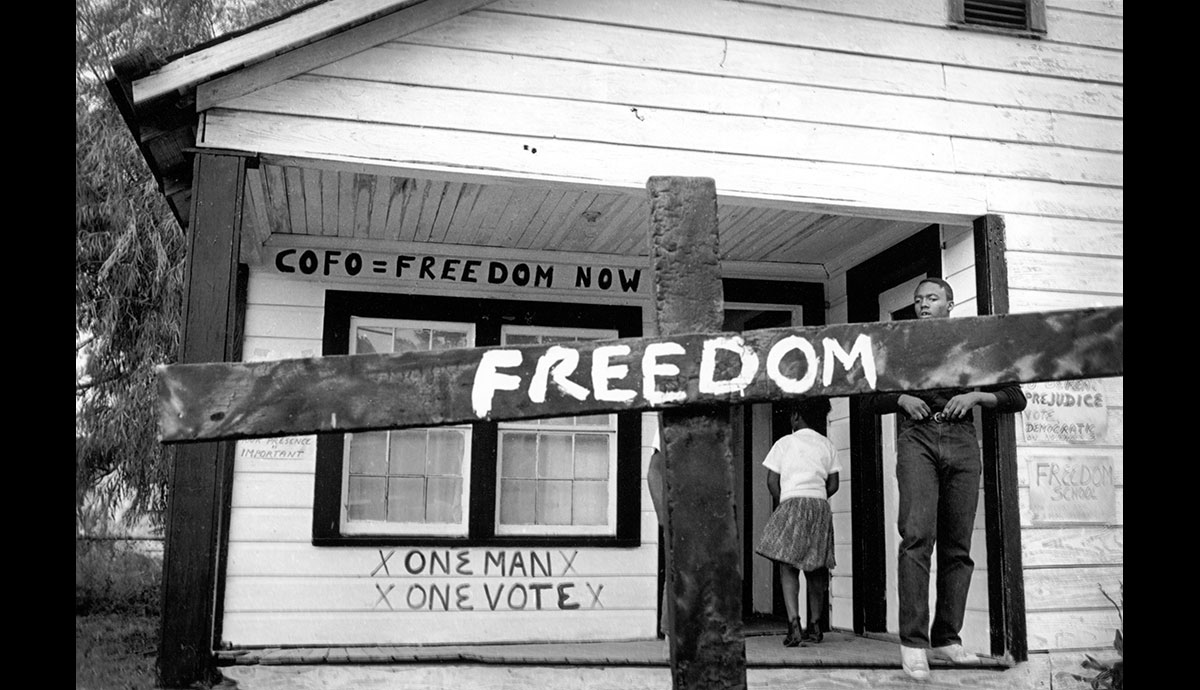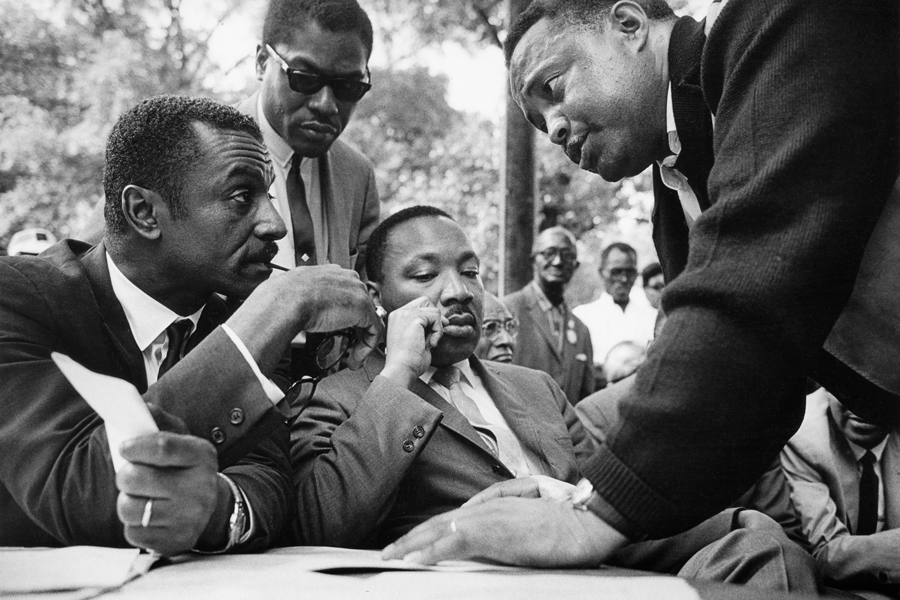This Light of Ours
Activist Photographers of the Civil Rights Movement
On view February 15, 2020 to May 31, 2020
Inside the Exhibition
This Light of Ours: Activist Photographers of the Civil Rights Movement presents the images of nine activist photographers who documented not only highly visible events but day-to-day organizing across the South in the 1960s. They captured on film a portrait of everyday people working together to produce a revolution in social justice.
More than 150 powerful black-and-white photos focus on the activities of the Student Non-Violent Coordinating Committee (SNCC) and are organized around four themes – Black Life, Organizing for Freedom, State and Local Terror, and Meredith March Against Fear and Black Power. The photographs convey SNCC’s distinctive “bottom-up” community organizing strategy as well as the movement’s impact on the national consciousness and use of photos to present critical messages.
As a special addition to the exhibition while it is in Austin, the Bullock Museum is pleased to include more than a dozen additional images representing activism and protest in Austin's own local history. The content was originally developed by the Austin History Center as part of their exhibition Taking It to the Streets: A Visual History of Protest and Demonstration in Austin, with the majority of images coming from their collections.
Black Life takes visitors through Mississippi and Alabama (with additional photos from Georgia, Louisiana, and Texas) encountering black people at home, at work, at church, at play, and in some movement activities. Images convey, in large part, people’s resilience, humor, strengths, determination, verve, beauty, and distress.
Organizing for Freedom engages SNCC’s community organizing, voter registration, and party building efforts from the 1963 Mississippi mock vote, through the unprecedented 1964 Summer Project and its national aftermath, all the way to the fall of 1966, when black people in Alabama voted for the first time for candidates put forth by their own Lowndes County Freedom Organization. The section makes evident the nexus between national policies and local conditions.
In State and Local Terror, the visitor will confront the varied expressions of white supremacy in Alabama and Mississippi as well as Georgia and Louisiana. These disturbing images present the “state” acting at various levels of government to intimidate and destroy the movement, local whites bluntly expressing their racist outlooks, and black people responding to the onslaught.
Meredith March shows the movement’s last great march and one of its complex and controversial outcomes. “Black Power,” or the empowerment of black people, was SNCC’s primary purpose, yet Stokely Carmichael’s impassioned presentation of the concept on the march frightened whites and caused deep divisions within the movement. Ironically, the vision unfolding in the Black Power concept telescoped the postmovement phase of national life when new power for black people was realized through movement-caused changes in American institutions and attitudes.
Bob Adelman (1930 - 2016) Working with the Congress of Racial Equality, Adelman photographed efforts to desegregate restaurants and bus terminals on Route 40 between Washington and New York. He went to Birmingham in 1963 with the Southern Christian Leadership Conference, where the images he captured garnered national and international recognition. He authored twelve books, including Mine Eyes Have Seen, a retrospective on the movement published in Life magazine’s 2007 “Great Photographer's Series.”
George “Elfie” Ballis (1925 - 2010) After working in Mississippi in the summer of 1964 for the Southern Documentary Project, Ballis returned to his California home and spent the next seven years documenting Cesar Chavez and the emerging United Farm Workers movement. He also produced several important documentary films, including I Am Joaquin, a Chicano film poem, and The Dispossessed, the struggle of California’s Pit River Indians to regain tribal lands.
Bob Fitch (1939 - 2016) An ordained minister, Fitch was 24 when he joined the Southern Christian Leadership Conference as a staff photographer in 1965. After nearly two years in the South, he spent the next two decades documenting social justice activities in California, including the work of Dorothy Day and the Catholic Worker houses of hospitality, and the efforts of Cesar Chavez and the United Farm Workers Union.
Bob Fletcher (1938 - ) After working for the Harlem Education Project in New York, Fletcher photographed for the Student Non-Violent Coordinating Committee in Alabama and Mississippi from 1964-1968. Becoming interested in documenting African life and culture, he worked on a documentary about Mozambique’s war of liberation, among other films shot on the continent. He later graduated from New York University's law school and became an attorney.
Matt Herron (1931 - ) One of the few photojournalists to bring his family with him, Herron covered the Civil Rights struggle for Life, Look and Time while also providing images for SNCC. During the 1964 Freedom Summer he organized the Southern Documentary Project, and his 1965 image of a Mississippi policeman wrestling an American flag from a black child won the World Press Photo Contest. His memoir, Mississippi Eyes: The Story and Photography of the Southern Documentary Project, was published in 2014.
David Prince (1942 - 2015) The only full-time college student employed as a photographer in the 1964 Southern Documentary Project, Prince, along with writer Jerry DeMuth was severely beaten by a Selma sheriff's posse at a voter registration site. That incident became notorious and led to a US Justice Department investigation. Prince continued to cover events in Mississippi until returning to school at Ohio University, where he later became a professor of film and a documentary filmmaker.
Herbert Randall (1936 - ) A freelance photographer until 1964, Randall spent that summer photographing Freedom Schools, voter registration drives, the Mississippi Freedom Democratic Party campaign and the people who served the movement. Returning to his home in New York, he received the Creative Artists’ Public Service Grant for Photography for 1971 - 1972 and later consulted for the National Media Center Foundation. He helped found a New York based forum for African American photographers.
Maria Varela (1940 - ) A Student Non-Violent Coordinating Committee staff member from 1963 - 1967, Varela specialized in photos illustrating the organization of economic cooperatives and voter registration campaigns. She later collaborated with Mexican American and Native American artisans and livestock growers to preserve pastoral cultures through sustainable development. She teaches about SNCC's organizing methods and legacies at Colorado College, where she is a visiting professor. She contributed to the collection Hands on the Freedom Plow: Personal Accounts by Women in SNCC.
Tamio Wakayama (1941 - 2018) Japanese Canadian who spent his childhood in a World War II internment camp, Wakayama skipped his final year of college to join the Civil Rights movement in 1963. He became a Student Non-Violent Coordinating Committee staffer in the Atlanta office, designing posters and fliers and managing the darkroom. In the summer of 1964, he worked as a field photographer in Mississippi. In 1976 he assembled A Dream of Riches: The Japanese Canadians 1877 1977.
- Member and VIP Preview Party
February 13, 6:30 p.m. - 8:30 p.m.
Member-only exhibition preview with hors d’oeuvres, complimentary drinks, and live music. - From Grassroots to Government: Teaching the Civil Rights Movement with Primary Sources
February 26, 9:00 a.m. - 3:30 p.m.
A professional development workshop exploring the history of the Civil Rights Movement - Liz and LadyBird: Whistlestop 1964!
Februrary 29, 2:00 p.m. - 3:00 p.m.
Join actor and author Sheila Gordon as she performs the story of Lady Bird Johnson traveling through the Deep South to sell the War on Poverty and Civil Rights agendas. - H-E-B Free First Sunday: Trailblazers
March 1, 12:00 pm - 5:00 pm
Enjoy free exhibition admission all day and family activities from noon to 3 pm. This month's H-E-B Free First Sunday focuses on those who have bravely forged new paths. - Evenings for Educators
March 11, 5:00 p.m. - 8:00 p.m.
Join us for a FREE event exclusively for teachers. - Storytime: Trailblazers
March 26, 10:00 am - 11:00 am
Listen to stories about brave people with big ideas who worked hard to make things better for others. - Reel Women in Film: The Divine Order
March 27, 7:00 p.m. - 9:00 p.m.
In 1971, a young housewife organizes the women of her town to petition for the right to vote in Switzerland. - Liz and LadyBird: Whistlestop 1964!
April 4, 2:00 p.m. - 3:00 p.m.
Join actor and author Sheila Gordon as she performs the story of Lady Bird Johnson traveling through the Deep South to sell the War on Poverty and Civil Rights agendas. - Reel Women in Film: Carmen Jones
April 10, 7:00 p.m. - 9:30 p.m.
Carmen Jones is a pop opera based on a 19th-century French opera about an independent woman who lives by her own rules and discards men when she grows tired of them. - Liz and LadyBird: Whistlestop 1964!
May 2, 2:00 p.m. - 3:00 p.m.
Join actor and author Sheila Gordon as she performs the story of Lady Bird Johnson traveling through the Deep South to sell the War on Poverty and Civil Rights agendas. - High Noon Talk: Texas Activism
May 06, 12:00 p.m. - 1:00p.m.
Join author and historian Max Krochmal as he reveals the often-overlooked foundations and liberal traditions of one of our nation’s most conservative states. - Reel Women in Film: Knock Down the House
May 22, 7:00 p.m. - 9:00 p.m.
This documentary focuses on the story of four women who were among the record number of women who ran for the United States Congress in 2018.
This Light of Ours: Activist Photographers of the Civil Rights Movement is presented by the Center for Documentary Expression and Art and the Maltz Museum of Jewish Heritage.
Major support for the exhibition has been provided by the Bruce W. Bastian Foundation and the National Endowment for the Arts, with use of the Bob Fitch photographs courtesy of the Department of Collections, Stanford University Libraries.
Sponsored locally by The Albert and Ethel Herzstein Hall Fund.
Special exhibitions are generously locally supported by Union Pacific.
Support for the Bullock Museum's exhibitions and education programs is provided by the Texas State History Museum Foundation.
Media Contact
| General Inquiries | |
|---|---|
| 512-463-5424 | |

